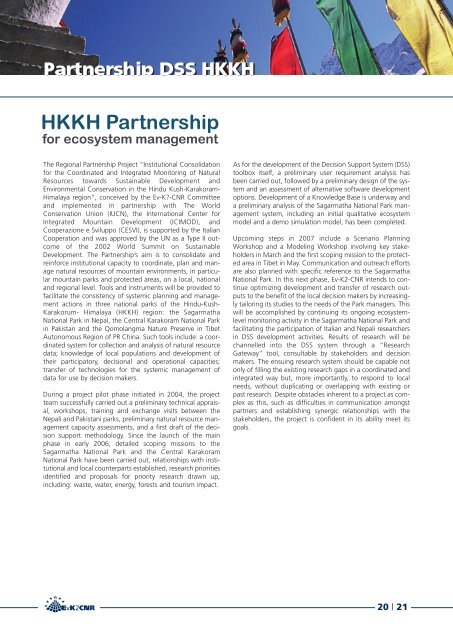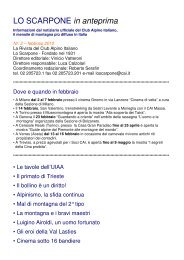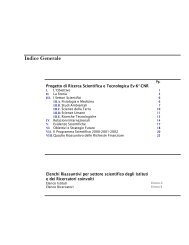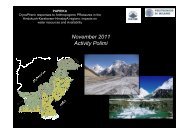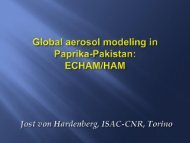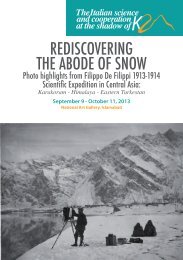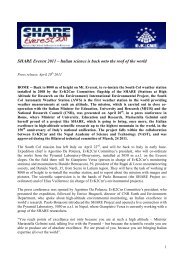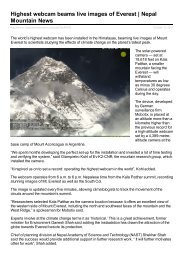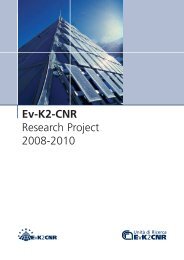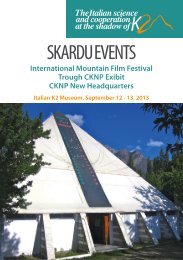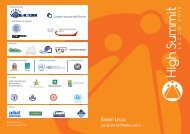Annual Report 2006 - Ev-K2-CNR
Annual Report 2006 - Ev-K2-CNR
Annual Report 2006 - Ev-K2-CNR
Create successful ePaper yourself
Turn your PDF publications into a flip-book with our unique Google optimized e-Paper software.
ar<strong>2006</strong> 19-09-2007 10:36 Pagina 22<br />
Partnership DSS HKKH<br />
The Regional Partnership Project “Institutional Consolidation<br />
for the Coordinated and Integrated Monitoring of Natural<br />
Resources towards Sustainable Development and<br />
Environmental Conservation in the Hindu Kush-Karakoram-<br />
Himalaya region”, conceived by the <strong>Ev</strong>-K?-<strong>CNR</strong> Committee<br />
and implemented in partnership with The World<br />
Conservation Union (IUCN), the International Center for<br />
Integrated Mountain Development (ICIMOD), and<br />
Cooperazione e Sviluppo (CESVI), is supported by the Italian<br />
Cooperation and was approved by the UN as a Type II outcome<br />
of the 2002 World Summit on Sustainable<br />
Development. The Partnership’s aim is to consolidate and<br />
reinforce institutional capacity to coordinate, plan and manage<br />
natural resources of mountain environments, in particular<br />
mountain parks and protected areas, on a local, national<br />
and regional level. Tools and instruments will be provided to<br />
facilitate the consistency of systemic planning and management<br />
actions in three national parks of the Hindu-Kush-<br />
Karakorum- Himalaya (HKKH) region: the Sagarmatha<br />
National Park in Nepal, the Central Karakoram National Park<br />
in Pakistan and the Qomolangma Nature Preserve in Tibet<br />
Autonomous Region of PR China. Such tools include: a coordinated<br />
system for collection and analysis of natural resource<br />
data; knowledge of local populations and development of<br />
their participatory, decisional and operational capacities;<br />
transfer of technologies for the systemic management of<br />
data for use by decision makers.<br />
During a project pilot phase initiated in 2004, the project<br />
team successfully carried out a preliminary technical appraisal,<br />
workshops, training and exchange visits between the<br />
Nepali and Pakistani parks, preliminary natural resource management<br />
capacity assessments, and a first draft of the decision<br />
support methodology. Since the launch of the main<br />
phase in early <strong>2006</strong>, detailed scoping missions to the<br />
Sagarmatha National Park and the Central Karakoram<br />
National Park have been carried out, relationships with institutional<br />
and local counterparts established, research priorities<br />
identified and proposals for priority research drawn up,<br />
including: waste, water, energy, forests and tourism impact.<br />
As for the development of the Decision Support System (DSS)<br />
toolbox itself, a preliminary user requirement analysis has<br />
been carried out, followed by a preliminary design of the system<br />
and an assessment of alternative software development<br />
options. Development of a Knowledge Base is underway and<br />
a preliminary analysis of the Sagarmatha National Park management<br />
system, including an initial qualitative ecosystem<br />
model and a demo simulation model, has been completed.<br />
Upcoming steps in 2007 include a Scenario Planning<br />
Workshop and a Modeling Workshop involving key stakeholders<br />
in March and the first scoping mission to the protected<br />
area in Tibet in May. Communication and outreach efforts<br />
are also planned with specific reference to the Sagarmatha<br />
National Park. In this next phase, <strong>Ev</strong>-<strong>K2</strong>-<strong>CNR</strong> intends to continue<br />
optimizing development and transfer of research outputs<br />
to the benefit of the local decision makers by increasingly<br />
tailoring its studies to the needs of the Park managers. This<br />
will be accomplished by continuing its ongoing ecosystemlevel<br />
monitoring activity in the Sagarmatha National Park and<br />
facilitating the participation of Italian and Nepali researchers<br />
in DSS development activities. Results of research will be<br />
channelled into the DSS system through a “Research<br />
Gateway” tool, consultable by stakeholders and decision<br />
makers. The ensuing research system should be capable not<br />
only of filling the existing research gaps in a coordinated and<br />
integrated way but, more importantly, to respond to local<br />
needs, without duplicating or overlapping with existing or<br />
past research. Despite obstacles inherent to a project as complex<br />
as this, such as difficulties in communication amongst<br />
partners and establishing synergic relationships with the<br />
stakeholders, the project is confident in its ability meet its<br />
goals.<br />
20 | 21


